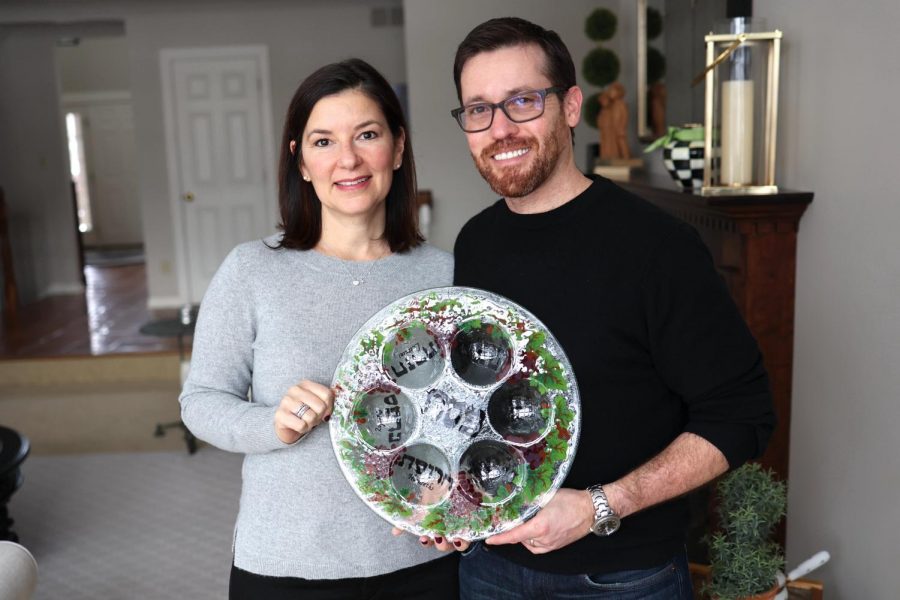Seder plates tell tales of family, Jewish histories
Published March 25, 2021
A few years ago, Bob Hoffman was getting new siding on his house. He was sitting on his living room couch just under where a Hoffman family heirloom – an antique seder plate – was hanging on the wall. Workers outside were banging on the exterior wall and, suddenly, the seder plate fell right into Hoffman’s lap.
“That was freaky,” he said. “I just happened to be right there at that exact moment, and the plate landed softly.”
Hoffman’s Spode bone china English seder plate has an intricate design that doubles as a seder how-to, with instructions including “wash the hands” and “eat the bitter herb.”
It’s a cherished belonging that’s been in his family for decades. And it’s part of his annual Passover seder. Hoffman knows his way around regular china, too. He’s director of catering operations at Congregation B’nai Amoona.
Jewish families in St. Louis like the Hoffmans have a tradition on Passover each year. They take from a safe place their special seder plates.
For Joyce and Bob Olshan, their plate is a reminder of their time living in Israel. Bob had just finished a seven-year stint in Israel as a representative of Boeing (then McDonnell-Douglas).
“My recollection is it came to us as a gift,” Joyce Olshan said. “It came from an art museum gift store, and it’s a replica of an original piece of art that’s a seder plate. What struck me when we first got it was I knew the original came from a time when the Jews were living as Marranos in Spain or Portugal.”
Olshan, who has a degree in Jewish history, explained that Marranos were forced to convert to Christianity during the Middle Ages, but many continued to practice Judaism in secret. The Olshan’s plate is unusual because there are a few typos that may very well have been intentional.
“A typical seder plate would have the words Pesach, seder, matzo and morar, but you’ll see here Pesach is spelled Pesar,” Olshan said. “It could be that it had been so long since this artist had been around Jewish people that he forgot how to spell the word, or it could be a purposeful typo so the Christian police wouldn’t realize that people with the plate were practicing Judaism.”
Olshan was familiar with this plate before she and her husband got it. It was in a book about Passover history she had owned since her studies at the yeshiva in Israel in the 1970s.
“To find the exact same plate in this history book for me personally, it was a real coincidence,” she said.
Ron and Roz Teper’s seder plate is an ornate china piece with raised gold letters and visual interpretations of the Old Testament, including a depiction of a baby Moses left in a basket in a clump of reeds. The plate is at least 60 years old and was passed down to Roz.
“It may have come from Italy originally,” she said. “It belonged to my Aunt Belle, my mother’s sister, Belle Wiseman Miller. She was married to Rabbi Julian Miller from B’nai El. My mother gave it to me because we always had a seder.”
Like the Teper’s seder plate, a common story for many Jewish families is a plate that doubles as a family heirloom. Laurie Sperling’s seder plate has been in her family since the 1950s.
“It’s definitely an heirloom,” Sperling said. “It’s made of metal, maybe tin, and when we use it we put little glass bowls in the indentations. I can’t figure out what the sixth indentation is so I use it for an orange, which is a more modern tradition.”
The inclusion of an orange on the seder plate is usually attributed to Susannah Heschel, professor of Jewish studies at Dartmouth College. Heschel included an orange in recognition of gay and lesbian Jews. Urban legend suggests that Heschel, while lecturing in Florida, was denounced by a man who said a woman belongs on the bimah as much as an orange belongs on the seder plate.
Brother and sister Laura Corn and David Montani each own unique seder plates. Corn and her husband, John, received theirs as a wedding gift 20 years ago. Montani’s seder plate belonged to his grandparents.
“They traveled a ton, so it could be from Israel, maybe it’s from Spain,” Montani said. “Or maybe it’s from Cleveland, where my grandmother was from. My guess is it’s probably from a trip to Israel around the 1960s.”
Brigitte Rosenberg, senior rabbi at United Hebrew Congregation, got her unusual seder plate in Israel at an artist’s coop in Jerusalem near Ben Yehuda Street.
“We’ve been going there since 1996 and we found this little coop where all kinds of artists display their work,” Rosenberg said. “We fell in love with it because it’s different from other seder plates. So many are circular. This was a totally different shape and we loved the fact that it’s simple and colorful.”
Another colorful seder plate owned by a Jewish St. Louisan isn’t a plate at all. It’s an artistic impression of a plate created by visual artist Marian Steen.
“Last year, when we all became familiar with the pandemic, we decided to have a Zoom seder,” Steen said. “We did it with our West Coast and East Coast relatives, as well as everyone here in St. Louis. As I was preparing the table, I realized that I didn’t have a seder plate. I went into the studio and did a painting of a seder plate and had it on exhibit during the whole Zoom. It was a hit!”















